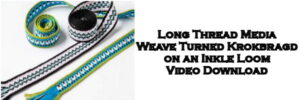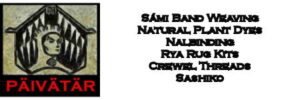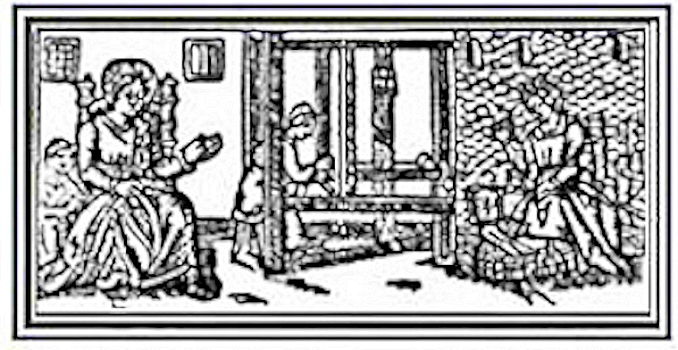A few years ago on a wonderful holiday to Corfu, Greece I purchased a beautiful sample of a Greek Flokati rug. It had been woven by my friend, Agathi the weaver, in Kassiopi, Corfu. She very kindly explained to me how these wonderful rugs are woven. The shaggy weft wool pile was made of handspun wool from local sheep. Her sister had done the hand spinning and Agathi woven this fluffy rug that now sits on my rocking chair.
The warp and ground weft is a 2-3 ply wool yarn woven in tabby weave. The handspun wool is cut into 15-20 cm lengths and then laid in between weft sheds, going under 3 raised warp threads. A shot of weft yarn is thrown across, change shed, and then the weft pile is woven back through 2 warp ends. This locks the cut pile firmly in place. Then 3 shots of ground weft are woven in tabby, before another row of handspun cut pile is laid across.

Flokati or Floccata rugs have a long history in Greece dating back some 1500-2000 years to villages in the northern mountainous regions of Greece. Sheepskins were used for warmth and the long shaggy pile of sheepskin was duplicated by weavers who inserted the wool locks into their woven rugs. These shaggy pile rugs are somewhat similar to the early rya pile rugs of Scandinavia, but the method of knotting the pile differs. IN a Flokati the cut pile is laid across the weft. In a Rya rug, the cut pile is wrapped and looped around the warp threads.
The definition of Flokati: “A Hand-woven shaggy 100% wool rug made in Greece.”
In 1966 the Greek government set standards for the Flokati rug industry. The law specified that for a rug to be classified as a “Flokati, it must be hand woven in Greece and must be made of 100% wool (warp, weft, and pile). Total weight of the rug must be at least 1800 grams of wool per square meter. The Flokati must be subjected to the water friction process for the pile to unravel and fluff out.
In the 1960’s Trikkala was the centre of the flokati rug industry and the wool market was held there in May and handweavers came from surrounding villages to buy their fleece, weaving tools and cotton yarns. There was a factory headquaraters in the centre of town where wool was carded and spun by machine. Weavers wovek the rugs in their homes, workig on narrow looms, threaded with singles yarn. The tufts were inserted without knotting at irrgular intervals. Because the looms were small and the woven rugs were thick, they had to be cut off the front roller of the loom frequently. The pieces were stitched together to create the larger rugs.
After weaving, the rug was heavily felted by heavy beating and immersion into pools or waterfalls. The flokati rugs were woven in natural white or alternating striped natural colours of browns, greys and creams. Natural dyes were also used on some of the rugs.
Flokati Rug Sample
I had about a meter left of wool warp on my loom after I wove a number of handspun blankets, so I thought I would try to weave a bit of Flokati.
Using the same wool yarn as was used for the warp, I wove several shots of tabby weave.
Cut the handspun yarn into 15-20 cm lengths. I cut a piece of cardboard into a width of 10 cm and wrapped the hand spun around it. Then cut the lengths of pile.
With an open shed in tabby weave, lay the cut pile ends across the weft, passing each thread under 3 raised warp ends. Repeat this across the width of the warp.
With the same shed still open, weave across a shot of the wool ground weft.
Change the shed.
I like to work from the right to the left, so I pick up the right side of the cut warp pile, and feed it back through 2 warp ends to the left. Repeat this across all of the handspun cut pile.
With the same shed still open, weave across a shot of the wool ground weft.
This locks the flocati pile firmly into place.
Weave another 2 shots of ground weft in tabby.
There will now be 3 shots of tabby weave between the row of pile.
Lay in another row of cut pile across the width of the warp as above. Alternate the spacing of the cut pile on each row so that the pile fills uniformly across (not directly above each other). Each row of pile should be about 1 cm apart, with 3 rows of ground tabby.
I will be weaving this Flokati rug sample with different types of handspun wool, to see what works best.
When it is complete, the rug will be fulled by washing and beating in the bathtub, to fluff out the pile.

References:
CIBA Review 1969/2 Greek Contemporary Handweaving
Where the Greek Flokati Rug is King Chicago Tribune, Apr 4, 1976
Agathis
Agathi, a wonderful and talented weaver I met in Kassiopi, Corfu
Corfu Spindle
Learning to spin on a Corfu style drop spindle.
 LONGTHREAD MEDIA VIDEO
LONGTHREAD MEDIA VIDEO
 LONGTHREAD MEDIA SUBSCRIPTIONS
HANDWOVEN MAGAZINE
PIECEWORK MAGAZINE
SPINOFF MAGAZINE
LEARN LONGTHREAD MEDIA
PAIVATAR HANDMADE
LONGTHREAD MEDIA SUBSCRIPTIONS
HANDWOVEN MAGAZINE
PIECEWORK MAGAZINE
SPINOFF MAGAZINE
LEARN LONGTHREAD MEDIA
PAIVATAR HANDMADE
 Paivatar on YouTube
Visit my YouTube channel for how-to craft videos.
Paivatar on YouTube
Visit my YouTube channel for how-to craft videos.
Or Please visit my Channel on Rumble for more how-to videos.
https://rumble.com/Paivatar
LIVE STREAMS - Paivatar Studio
KICK
TWITCH MAKERS&CRAFTING
YOUTUBE
Categories: HAND WEAVING, Heritage Crafts, Rug Weaving












